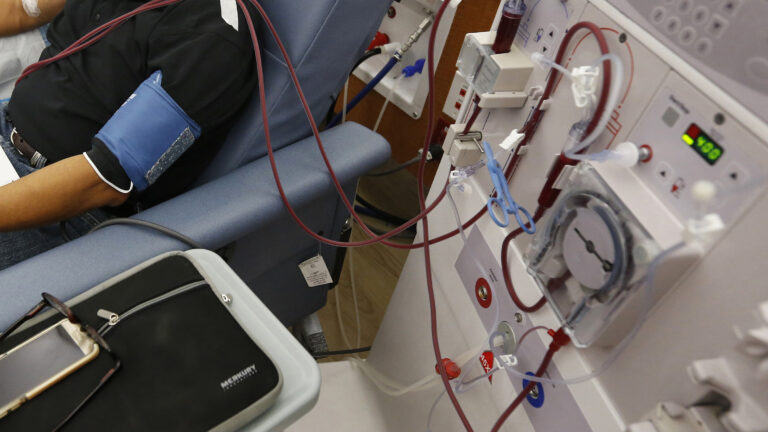Editor’s note: This op-ed was first published by STAT on April 29, 2021.
The Covid-19 relief bill that President Joe Biden signed into law in March temporarily expanded the subsidies available to people who buy their health insurance through marketplaces established under the Affordable Care Act, and the administration has proposed to make those subsidies permanent as part of the American Families Plan. To help pay for that effort, Congress should end a game that big dialysis companies play with insurance to pad their profits at federal expense.
Approximately 470,000 Americans with kidney failure undergo dialysis, a life-saving but expensive treatment, generally three times a week. Most of them are eligible for comprehensive coverage through Medicare, even if they are under 65. Others are eligible for state Medicaid programs.
Private insurers, including group and individual plans, pay dialysis providers more than Medicare or Medicaid — a lot more. Research we conducted with several colleagues shows that private individual market plans pay about three times more for dialysis than Medicare pays.
This is where the gaming comes in. Dialysis facilities have tried to push their patients into individual market plans, in part by financing patients’ premiums for those plans. To do that, they make donations to the American Kidney Fund, a nonprofit organization that reportedly receives 80% of its budget from DaVita and Fresenius, the two big companies that dominate the dialysis market in the United States. The American Kidney Fund then uses those “charitable” contributions to pay the premiums of dialysis patients who enroll in individual market plans.
This scheme is lucrative for dialysis facilities. Our research found that individual market plans paid about $10,100 per month for dialysis services per patient in 2016 (the last year of data available to us), while Medicare paid about $3,300 per month. Covering a patient’s individual market premium (via the American Kidney Fund) typically costs only several hundred dollars per patient per month. For that outlay, a dialysis facility would have pocketed most of the nearly $7,000 difference in payments. That’s not a bad return on investment.
While this scheme is lucrative for dialysis facilities, it raises premiums across the individual market. Our research shows that the health care spending of individual market enrollees receiving dialysis was about 33 times the spending of enrollees not receiving dialysis.
It’s not known how many people have been enrolled in the individual market because they were steered in that direction by dialysis facilities, or how many might become enrolled in the future if policymakers fail to act. But we estimate that shifting even one-fifth of non-elderly Medicare dialysis patients into the individual market would have increased health care spending in the individual market by 8% in 2016, or almost $7 billion.
The lion’s share of that extra $7 billion would have been paid by the federal government, which subsidizes premiums for most individual market enrollees. The additional subsidy costs would likely have outweighed any savings from covering fewer people under Medicare. Individual market enrollees who did not qualify for federal subsidies would have paid higher premiums themselves. In the future, more of the burden of dialysis costs will likely fall on the government rather than individuals if the recent expansions of federal subsidies become permanent.
These added costs might be worth bearing if dialysis patients were clearly better off in the individual market, either financially or otherwise. But they generally aren’t. Patients might face higher out-of-pocket costs if they enroll in traditional Medicare which, unlike individual market coverage, does not cap enrollees’ annual out-of-pocket spending. However, these patients would usually face comparable or lower costs if they opted for private Medicare Advantage plans (which do cap annual out-of-pocket spending) or obtained Medicare supplemental coverage (which covers traditional Medicare’s out-of-pocket costs). And the American Kidney Fund pays premiums for these Medicare coverage options too. Individual market plans also often have narrower networks that can force patients to switch providers.
Policymakers have a couple options to end the ability of dialysis companies to game this system. First, they could cap payments to dialysis facilities for services delivered to Medicare- or Medicaid-eligible enrollees whose premiums are subsidized by third parties like the American Kidney Fund, eliminating the incentive for dialysis facilities to steer patients into private plans. Second, they could bar third parties from subsidizing individual market coverage on behalf of Medicare- or Medicaid-eligible patients or bar dialysis companies from donating to third parties that do so.
A California law enacted last year took both of these approaches, while federal regulators pursued a version of the second approach in the 2016. Both the California and federal efforts ultimately ran into trouble in the courts. But Congress could be successful where others have failed because its authority is broader than that of a state or a federal agency.
Congress should act to stop this practice. The only real cost would be lower profits for the dialysis industry. And if Congress used the savings wisely, the benefit could help broaden insurance coverage and lower premiums for everyone in the individual market.
